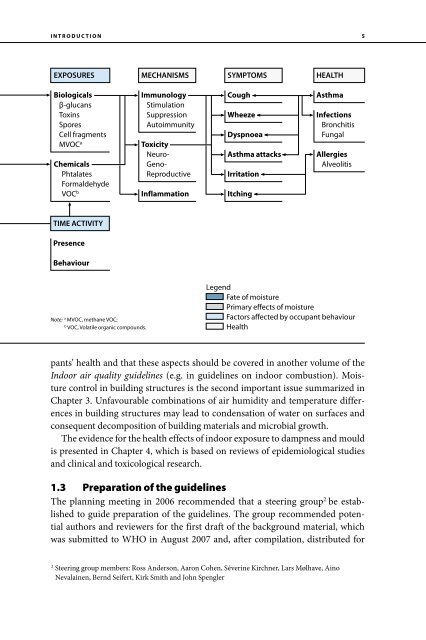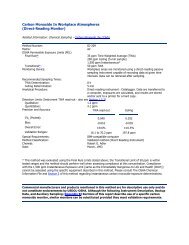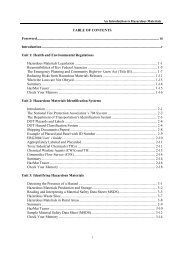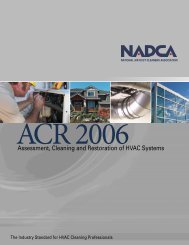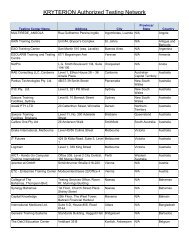- Page 1: WHO GUIDELINES FOR INDOOR AIR QUALI
- Page 4 and 5: Keywords AIR POLLUTION, INDOOR - ad
- Page 6 and 7: Abstract Microbial pollution is a k
- Page 8 and 9: 4. Health effects associated with d
- Page 10 and 11: VIII WHO GUIDELINES FOR INDOOR AIR
- Page 12 and 13: X Acknowledgements Preparation of t
- Page 14 and 15: XII Executive summary This document
- Page 16 and 17: XIV WHO GUIDELINES FOR INDOOR AIR Q
- Page 18 and 19: XVI WHO GUIDELINES FOR INDOOR AIR Q
- Page 20 and 21: 2 WHO GUIDELINES FOR INDOOR AIR QUA
- Page 24 and 25: 6 WHO GUIDELINES FOR INDOOR AIR QUA
- Page 26 and 27: 8 WHO GUIDELINES FOR INDOOR AIR QUA
- Page 28 and 29: 10 WHO GUIDELINES FOR INDOOR AIR QU
- Page 30 and 31: 12 WHO GUIDELINES FOR INDOOR AIR QU
- Page 32 and 33: 14 WHO GUIDELINES FOR INDOOR AIR QU
- Page 34 and 35: 16 WHO GUIDELINES FOR INDOOR AIR QU
- Page 36 and 37: 18 WHO GUIDELINES FOR INDOOR AIR QU
- Page 38 and 39: 20 WHO GUIDELINES FOR INDOOR AIR QU
- Page 40 and 41: 22 WHO GUIDELINES FOR INDOOR AIR QU
- Page 42 and 43: 24 WHO GUIDELINES FOR INDOOR AIR QU
- Page 44 and 45: 26 WHO GUIDELINES FOR INDOOR AIR QU
- Page 46 and 47: 28 WHO GUIDELINES FOR INDOOR AIR QU
- Page 49 and 50: 31 3. Moisture control and ventilat
- Page 51 and 52: MOISTURE CONTROL AND VENTILATION 33
- Page 53 and 54: MOISTURE CONTROL AND VENTILATION 35
- Page 55 and 56: MOISTURE CONTROL AND VENTILATION 37
- Page 57 and 58: MOISTURE CONTROL AND VENTILATION 39
- Page 59 and 60: MOISTURE CONTROL AND VENTILATION 41
- Page 61 and 62: MOISTURE CONTROL AND VENTILATION 43
- Page 63 and 64: MOISTURE CONTROL AND VENTILATION 45
- Page 65 and 66: MOISTURE CONTROL AND VENTILATION 47
- Page 67 and 68: MOISTURE CONTROL AND VENTILATION 49
- Page 69 and 70: MOISTURE CONTROL AND VENTILATION 51
- Page 71 and 72: MOISTURE CONTROL AND VENTILATION 53
- Page 73 and 74:
MOISTURE CONTROL AND VENTILATION 55
- Page 75 and 76:
MOISTURE CONTROL AND VENTILATION 57
- Page 77 and 78:
MOISTURE CONTROL AND VENTILATION 59
- Page 79 and 80:
MOISTURE CONTROL AND VENTILATION 61
- Page 81 and 82:
63 4. Health effects associated wit
- Page 83 and 84:
HEALTH EFFECTS ASSOCIATED WITH DAMP
- Page 85 and 86:
HEALTH EFFECTS ASSOCIATED WITH DAMP
- Page 87 and 88:
HEALTH EFFECTS ASSOCIATED WITH DAMP
- Page 89 and 90:
HEALTH EFFECTS ASSOCIATED WITH DAMP
- Page 91 and 92:
HEALTH EFFECTS ASSOCIATED WITH DAMP
- Page 93 and 94:
HEALTH EFFECTS ASSOCIATED WITH DAMP
- Page 95 and 96:
HEALTH EFFECTS ASSOCIATED WITH DAMP
- Page 97 and 98:
HEALTH EFFECTS ASSOCIATED WITH DAMP
- Page 99 and 100:
HEALTH EFFECTS ASSOCIATED WITH DAMP
- Page 101 and 102:
HEALTH EFFECTS ASSOCIATED WITH DAMP
- Page 103 and 104:
HEALTH EFFECTS ASSOCIATED WITH DAMP
- Page 105 and 106:
HEALTH EFFECTS ASSOCIATED WITH DAMP
- Page 107 and 108:
HEALTH EFFECTS ASSOCIATED WITH DAMP
- Page 109 and 110:
HEALTH EFFECTS ASSOCIATED WITH DAMP
- Page 111 and 112:
93 5. Evaluation of human health ri
- Page 113:
EVALUATION OF HUMAN HEALTH RISKS AN
- Page 116 and 117:
98 WHO GUIDELINES FOR INDOOR AIR QU
- Page 118 and 119:
100 WHO GUIDELINES FOR INDOOR AIR Q
- Page 120 and 121:
102 WHO GUIDELINES FOR INDOOR AIR Q
- Page 122 and 123:
104 WHO GUIDELINES FOR INDOOR AIR Q
- Page 124 and 125:
106 WHO GUIDELINES FOR INDOOR AIR Q
- Page 126 and 127:
108 WHO GUIDELINES FOR INDOOR AIR Q
- Page 128 and 129:
110 WHO GUIDELINES FOR INDOOR AIR Q
- Page 130 and 131:
112 WHO GUIDELINES FOR INDOOR AIR Q
- Page 132 and 133:
114 WHO GUIDELINES FOR INDOOR AIR Q
- Page 134 and 135:
116 WHO GUIDELINES FOR INDOOR AIR Q
- Page 136 and 137:
118 WHO GUIDELINES FOR INDOOR AIR Q
- Page 138 and 139:
120 WHO GUIDELINES FOR INDOOR AIR Q
- Page 140 and 141:
122 WHO GUIDELINES FOR INDOOR AIR Q
- Page 142 and 143:
124 WHO GUIDELINES FOR INDOOR AIR Q
- Page 144 and 145:
126 WHO GUIDELINES FOR INDOOR AIR Q
- Page 146 and 147:
128 WHO GUIDELINES FOR INDOOR AIR Q
- Page 148 and 149:
130 HEALTH RISKS OF OZONE FROM LONG
- Page 151 and 152:
133 Annex 1. Summary of epidemiolog
- Page 153 and 154:
ANNEX 1. SUMMARY OF EPIDEMIOLOGICAL
- Page 155 and 156:
ANNEX 1. SUMMARY OF EPIDEMIOLOGICAL
- Page 157 and 158:
ANNEX 1. SUMMARY OF EPIDEMIOLOGICAL
- Page 159 and 160:
ANNEX 1. SUMMARY OF EPIDEMIOLOGICAL
- Page 161 and 162:
ANNEX 1. SUMMARY OF EPIDEMIOLOGICAL
- Page 163 and 164:
ANNEX 1. SUMMARY OF EPIDEMIOLOGICAL
- Page 165 and 166:
ANNEX 1. SUMMARY OF EPIDEMIOLOGICAL
- Page 167 and 168:
ANNEX 1. SUMMARY OF EPIDEMIOLOGICAL
- Page 169 and 170:
ANNEX 1. SUMMARY OF EPIDEMIOLOGICAL
- Page 171 and 172:
ANNEX 1. SUMMARY OF EPIDEMIOLOGICAL
- Page 173 and 174:
ANNEX 1. SUMMARY OF EPIDEMIOLOGICAL
- Page 175 and 176:
ANNEX 1. SUMMARY OF EPIDEMIOLOGICAL
- Page 177 and 178:
ANNEX 1. SUMMARY OF EPIDEMIOLOGICAL
- Page 179 and 180:
ANNEX 1. SUMMARY OF EPIDEMIOLOGICAL
- Page 181 and 182:
ANNEX 1. SUMMARY OF EPIDEMIOLOGICAL
- Page 183 and 184:
ANNEX 1. SUMMARY OF EPIDEMIOLOGICAL
- Page 185 and 186:
ANNEX 1. SUMMARY OF EPIDEMIOLOGICAL
- Page 187 and 188:
ANNEX 1. SUMMARY OF EPIDEMIOLOGICAL
- Page 189 and 190:
ANNEX 1. SUMMARY OF EPIDEMIOLOGICAL
- Page 191 and 192:
ANNEX 1. SUMMARY OF EPIDEMIOLOGICAL
- Page 193 and 194:
ANNEX 1. SUMMARY OF EPIDEMIOLOGICAL
- Page 195 and 196:
ANNEX 1. SUMMARY OF EPIDEMIOLOGICAL
- Page 197 and 198:
ANNEX 1. SUMMARY OF EPIDEMIOLOGICAL
- Page 199 and 200:
ANNEX 1. SUMMARY OF EPIDEMIOLOGICAL
- Page 201 and 202:
ANNEX 1. SUMMARY OF EPIDEMIOLOGICAL
- Page 203 and 204:
ANNEX 1. SUMMARY OF EPIDEMIOLOGICAL
- Page 205 and 206:
ANNEX 1. SUMMARY OF EPIDEMIOLOGICAL
- Page 207 and 208:
ANNEX 1. SUMMARY OF EPIDEMIOLOGICAL
- Page 209 and 210:
ANNEX 1. SUMMARY OF EPIDEMIOLOGICAL
- Page 211 and 212:
ANNEX 1. SUMMARY OF EPIDEMIOLOGICAL
- Page 213 and 214:
ANNEX 1. SUMMARY OF EPIDEMIOLOGICAL
- Page 215 and 216:
ANNEX 1. SUMMARY OF EPIDEMIOLOGICAL
- Page 217 and 218:
ANNEX 1. SUMMARY OF EPIDEMIOLOGICAL
- Page 219 and 220:
ANNEX 1. SUMMARY OF EPIDEMIOLOGICAL
- Page 221 and 222:
ANNEX 1. SUMMARY OF EPIDEMIOLOGICAL
- Page 223 and 224:
ANNEX 1. SUMMARY OF EPIDEMIOLOGICAL
- Page 225 and 226:
ANNEX 1. SUMMARY OF EPIDEMIOLOGICAL
- Page 227 and 228:
ANNEX 1. SUMMARY OF EPIDEMIOLOGICAL
- Page 229 and 230:
ANNEX 1. SUMMARY OF EPIDEMIOLOGICAL
- Page 231 and 232:
ANNEX 1. SUMMARY OF EPIDEMIOLOGICAL
- Page 233 and 234:
215 Annex 2. Summary of in vitro an
- Page 235 and 236:
ANNEX 2. SUMMARY OF IN VITRO AND IN
- Page 237 and 238:
ANNEX 2. SUMMARY OF IN VITRO AND IN
- Page 239 and 240:
ANNEX 2. SUMMARY OF IN VITRO AND IN
- Page 241 and 242:
ANNEX 2. SUMMARY OF IN VITRO AND IN
- Page 243 and 244:
ANNEX 2. SUMMARY OF IN VITRO AND IN
- Page 245 and 246:
ANNEX 2. SUMMARY OF IN VITRO AND IN
- Page 248:
When sufficient moisture is availab


